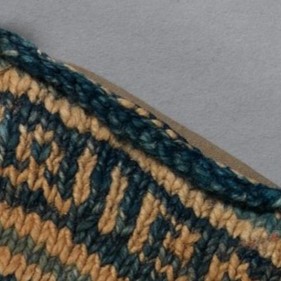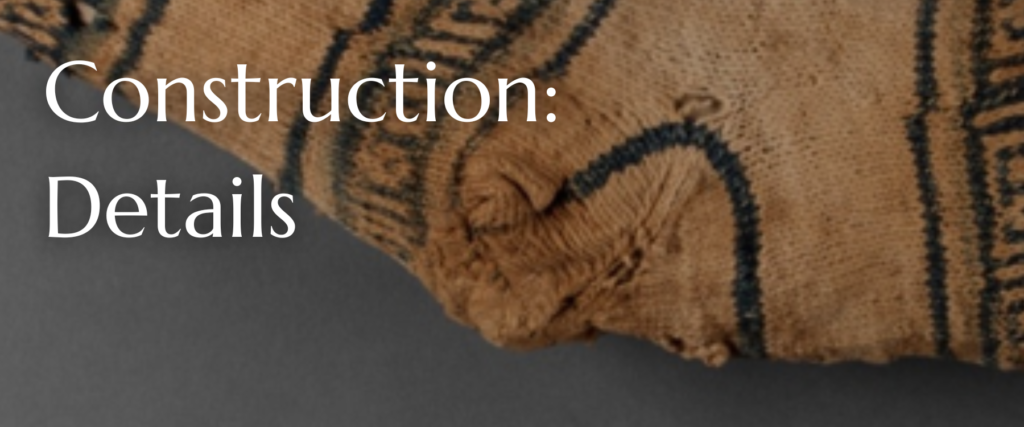To those familiar with knitted garments, this sock of course appears to have been knit. To those unfamiliar, the title of this page suggests it was. Indeed, this sock is currently believed to be among the earliest examples of knitting in Afro-Eurasia, separate from its independent development in South America. But what actually separates knitting from other methods of fabric construction, like weaving or nålbinding?
In his book A History of Hand Knitting, independent knitting scholar Richard Rutt defines a knitted fabric as “a fabric consisting solely of parallel courses of yarn, each course meshed into the fabric by being looped into bights of a course above. Only in the last course are the loops locked by being laterally looped into the same course,” based on Irene Emery’s definition in The Primary Structures of Fabrics.1 Several methods of fabric creation other than weaving have a visible similarity specifically to stockinette, which is a smooth fabric in which the “right” side has V-shaped “knit” stitches and the “wrong” side has short horizontal “purl” stitches.
The “parallel courses of yarn” are more commonly referred to as “rows” and this is where the clearest difference between knitting and weaving appears. Woven fabrics are created with a warp and a weft, which are set perpendicular to each other. As the diagram on the right shows, this usually results in a very different looking fabric from knit fabric. Tablet weaving is able to produce a fabric similar to knitting, but there are still two sets of perpendicular threads and the “wrong” side of the fabric is the same as the front; it does not have the appearance of “purl” stitches.2 Additionally, it would be much more difficult to create a shaped garment via tablet weaving, which is most commonly used to create long, narrow strips of fabric.



An alternative method that can produce a fabric identical to knitted fabric is nålbinding. This was the method most commonly used to make earlier objects that appear to be knit upon first glance, like the above sock from the Roman/Byzantine era in Egypt. Both knitting and nålbinding seem primarily used to make socks early on.3 Even in colder climates, knitting was initially used primarily to make accessories like socks, stockings, and hats. Two critical differences between fabrics produced by nålbinding and those produced by knitting are in the direction of the work and its increase/decrease structure. Nålbinding was done with a regular eyed needle and traveled across the row one stitch at a time, with the loops anchored at the bottom of the fabric. In knitting, the loops are at the top, and “looped” around the needles, since all working stitches need to be held on needles in order to avoid unraveling. Rutt posits that the switch from nålbinding to knitting was made when people in Egypt realized they could pull new loops through old loops, rather than looping them around the old loops.4 He also writes that early knitting was almost all done in the round, on what are essentially precursors to today’s double-pointed needles.5 Early knitting needles had blunt tips, it was not until the 19th century that the point of the needle became important to knitters.6 Knitting in the round also has the advantages that the maker can see the shape of the object as they work, they only need one kind of stitch if using stockinette (as early samples of knitting all are), and they would not have to stitch up the seam at the end of the project.
There is also crochet, which is popular among handcrafters today, but does not appear until centuries after this sock was made and has a different appearance.
So how do we know that this sock is knit? Let’s start by knocking out the alternatives. We can tell from the stretched portions of the sock, like the edge of the heel shown below left, that there is no perpendicular thread running through (in case you were holding out for tablet weaving). It was trickier to determine whether this was nålbinding, because they look so similar. In that same image, you can see that the stitches are not “twisted”, meaning that the bottom of the V shape is separated by a gap versus having a crossover. Knitwear designer Susanna Winter knit the sample below center that effectively shows how twisted stockinette looks in comparison to regular stockinette.



Due to its fragile condition, I was not able to personally handle the sock or move it into a different position than the ones seen here to fully inspect it. However, a small amount of the inside of the sock is visible at the top, and shows the distinctive purled reverse side of stockinette fabric. Nålbinding can produce the same kind of interior appearance, so the outer side of stockinette is the only one that can relied upon to differentiate. Another way to tell is by examining the decreases. Because nålbinding is worked in the opposite direction from knitting, the stitches would decrease top-down rather than bottom-up. The heel, the only area with decrease stitches, has stitches clearly being knit two together from the bottom-up rather than the nålbinding style.
To read more about how I converted this research into reconstruction, visit Recreating the Sock. To examine other details of the sock, return to the homepage. For those looking a more hands-on experience…
If you’re interested in knitting, Purl Soho has a vast library of tutorials, including this one for absolute beginners:
If you’re interested in nålbinding, here is a playlist from historical reenactor Ylva the Red:
Footnotes
- Richard Rutt, A History of Hand Knitting (U.S. ed. Loveland, Colorado: Interweave Press, 1987), 7.
- Rutt, Hand Knitting, 11.
- Rutt, Hand Knitting, 23; also see the Textile Museum at George Washington University’s collection of early knitting and nålbinding.
- Rutt, Hand Knitting, 23.
- Ibid.
- Rutt, Hand Knitting, 16.


